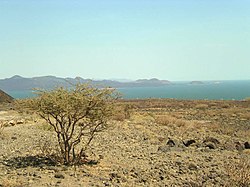As you crawl forward in your 4x4, the so-called Jade Sea emerges before you. A vast, deep-green oasis in an otherwise barren hellscape. But this is not your storybook oasis. The water is undrinkable. The wind unrelenting. And basks of crocodiles eye you warily from the shore. Welcome to the world's largest desert lake, Lake Turkana.
Understand
[edit]
Lake Turkana is an oasis but in the strictly metaphorical sense. Though the climate is unforgivably harsh, hominids have been living here for millions of years. The hardiest among us remain today, along with hippos, crocodiles, and hundreds of bird species. Kindly turtles thrive... as do a multitude of venomous snakes, among them the cobra, the puff adder, and the ever-pleasant carpet viper. But what would you expect in a land such as this? Volcanic cones rise from the lake, dark and foreboding and occasionally erupting but mostly as dead or dormant as everything but the lake itself.
Sibiloi National Park sits on the northeastern shore. Known as the "Cradle of Mankind", it has revealed hominid fossils dating back millions years. These include a near-complete Homo erectus skeleton, aptly named Turkana Boy. The oldest tool-making hominid, Kenyanthropus, dating back 3.5 million years, was also discovered here.
In the middle of the lake is Central Island, also known as Crocodile Island, made up of over a dozen volcano cones replete with crater lakes that are a haven for every reptile listed above. It's a lovely visit, if lonely... and expensive... and treacherous. Those winds? They kick up one hell of a storm.

Despite all this, we hominids still live here today, although our tribes are limited to the hardiest among us. The El Molo people live here, on the eastern shore – there is maybe 1,000 of them left. The Turkana people more than take up the balance, numbering some million strong throughout Kenya but with their base on the western shores of Lake Turkana. As renown for their craftsmanship as they are for their warrior prowess, you might pick up the most exotic of wares from the most naked of salesmen if you make it to Lake Turkana. And of course you would, here.
Get in
[edit]You can arrange a safari from Nairobi. There are also airstrips in the area.
Otherwise, by land, you can attack from the east or you can attack from the west. Regardless, first step: get a 4x4 vehicle.
From the east (recommended): Get to Marsabit, which is a town worth visiting in its own right. Then turn northwest onto C82 to Kalacha. From there, continue northwest on C82 to North Horr where you need to make a right turn on to C77. This will lead you to Lake Turkana and the town of Loiyangalani.
From the west: Get to Lodwar. From Lodwar there are several roads that will take you to Lake Turkana. E1354 via D348 will take you to the remote village of Eliye Springs which has white-sand beaches and accommodation.
Get around
[edit]With luck, you should be able to rent a boat in Loiyangalani, weather conditions and availability permitting.
See and do
[edit]- 1 Sibiloi National Park. The "Cradle of Mankind", an archeological site containing fossils millions of years old.
- 2 Central Island National Park. An intriguing island full of volcanic wonders and dangerous reptiles.
- 3 South Island National Park. Nicknamed the "Isle of Mystery", hard to reach but it glows at night and is rumoured to be haunted by evil spirits.
- Lake Turkana Cultural Festival (Tobong'u Lore). One of the largest cultural festivals in Kenya, hosted by the El Molo and the Turkana people.
Buy
[edit]
The Turkana are renown craftsmen. If you're keen on exotic wares, this might be the place to find them. Along with myriad weapons, particularly renown are ostrich-feathered Turkana headdresses.
Eat
[edit]Drink
[edit]Sleep
[edit]Go next
[edit]- Marsabit. The Kenyan frontier, if you hadn't already been to Lake Turkana
- Lodwar. A lively market town, capital of Turkana county

